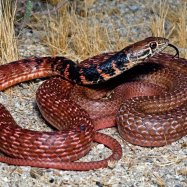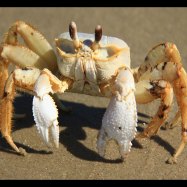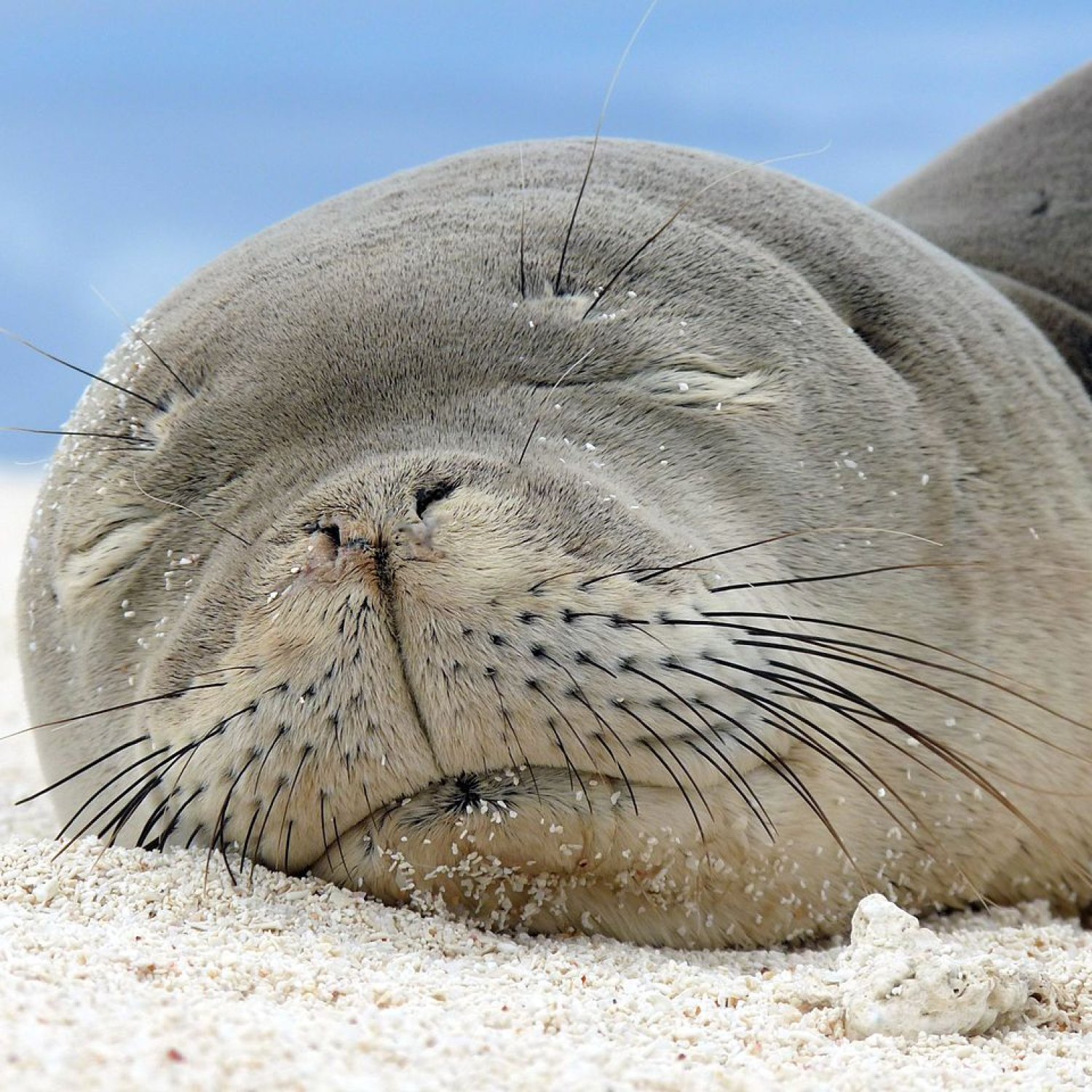
Hawaiian Monk Seal
About 7 feet (2.1 meters)
The Hawaiian Monk Seal, found in the Pacific Ocean, is a rare and unique mammal known for its slender and streamlined body shape. Standing at about 7 feet (2.1 meters) in length, this seal is a member of the Phocidae family and is one of the largest species of seal in the world. Sadly, these animals are endangered due to human impact and conservation efforts are crucial for their survival. #HawaiianMonkSeal #PacificOcean #Conservation
Animal Details Summary:
Common Name: Hawaiian Monk Seal
Kingdom: Animalia
Habitat: Coastal waters
The Enigmatic Hawaiian Monk Seal: A Mysterious Creature of the Pacific
Amid the turquoise waters of the Pacific Ocean, a creature lurks in the depths, hiding in plain sight among the bustling ecosystem of the Hawaiian Islands. Its dark, grayish coloration blends seamlessly into the rocky terrain, and its slender, streamlined body makes it a swift swimmer. With a length of about 7 feet, this animal may seem like many other seals at first glance, but it is anything but ordinary. We are talking about the enigmatic Hawaiian monk seal (Monachus schauinslandi), a rare and mysterious creature that has captured the hearts and minds of many Hawaiian Monk Seal.As its name suggests, the Hawaiian monk seal is native to the Hawaiian Islands, but its existence is threatened by a multitude of reasons. Despite being classified as a protected species, their population continues to decline, with only about 1,400 individuals remaining in the wild. So, what makes this creature so unique, and why is it struggling to survive?
To understand the importance of the Hawaiian monk seal, let us take a closer look at its taxonomy, physical characteristics, habitat, and the challenges it faces.
A Taxonomic Marvel
The Hawaiian monk seal belongs to the Animalia kingdom, which includes all animals, and falls under the Phylum Chordata – animals with a notochord (the precursor to the backbone). They are also classified under the Class Mammalia, meaning they have hair, produce milk for their young, and are warm-blooded. Further down the taxonomic ladder, they belong to the Order Carnivora, which includes many other predatory mammals like bears, cats, and dogs.Within this order, the Hawaiian monk seal belongs to the Family Phocidae, better known as the true seals. These seals do not have external ear flaps, have short front flippers, and are exclusively marine animals.
Interestingly, the Hawaiian monk seal is the only species in the Monachus genus, which makes it one of the most genetically distinct seals in the world Hummingbird Hawk Moth. Its closest relative is the Mediterranean monk seal (Monachus monachus), with whom it shares a common ancestor from millions of years ago.
Unmistakable Physical Characteristics
Although it may look like an ordinary seal at first glance, the Hawaiian monk seal has several unique physical features that set it apart from its counterparts. As mentioned earlier, these seals have a dark gray coloration with a lighter belly, making them appear almost black in the water and blending in with the rocky habitat of the Hawaiian Islands.Their body shape is also distinctive, with a slender and streamlined appearance. This body shape allows them to move smoothly through the water, making them efficient hunters. In addition to this, Hawaiian monk seals have large, forward-facing eyes, giving them excellent vision, both on land and underwater.
One of the most striking features of the Hawaiian monk seal is their whiskers, which they use to detect movements and vibrations in the water. These sensitive whiskers, known as vibrissae, help them locate prey, even in murky waters.
A Habitat Unique to the Hawaiian Islands
As their name suggests, the Hawaiian monk seals are only found in the Hawaiian Islands, making their habitat unique and highly specific. These islands, situated in the Pacific Ocean, are known for their pristine beaches, crystal-clear waters, and diverse marine life – the perfect home for the Hawaiian monk seal.In particular, these seals can be found along the coastlines of the uninhabited islands, away from human interference. They prefer rocky shorelines and shallow waters, where they can easily hunt for their prey – fish, squid, and octopus.
Sadly, due to human development and tourism, the Hawaiian monk seal's habitat is continuously being encroached upon, leaving these creatures struggling to find suitable places to rest and raise their young.
An Acrobatic Carnivore
Although they may seem docile and peaceful lounging on the beaches, the Hawaiian monk seal is a skilled and agile hunter in the water. As mentioned earlier, they mainly feed on fish, squid, and octopus, using their strong jaws and sharp teeth to capture and consume their prey.Their flexible bodies and large front flippers allow them to swim swiftly and maneuver through the water, making them quite acrobatic. They often use these skills to hunt cooperatively, with multiple seals working together to herd schools of fish and catch them more efficiently.
Limited Geographical Distribution
The Hawaiian monk seal is endemic to the Hawaiian Islands, meaning it is not found anywhere else in the world. These islands, which are part of the United States, are a cluster of eight main islands and several smaller ones, totaling over 130 islands in total.Despite being found on multiple islands, the Hawaiian monk seal's population is highly concentrated, with most individuals found on the uninhabited Northwestern Hawaiian Islands. Only a few hundred individuals inhabit the main Hawaiian Islands, making them a rarer sight to spot.
A National Treasure and an Endangered Species
Given its unique status as an endemic species to the United States, the Hawaiian monk seal holds a special place in the hearts of many Americans. In fact, it was officially declared the official state mammal in 2008.However, despite this recognition and protection, Hawaiian monk seals remain an endangered species. The International Union for Conservation of Nature (IUCN) has classified them as critically endangered, with a decreasing population trend.
The Hawaiian monk seal faces multiple threats, including habitat loss due to coastal development, entanglement in fishing gear, and accidental ingestion of marine debris. They are also susceptible to diseases and parasites, which can severely impact their already small population.
Additionally, human disturbance, particularly during their breeding season, can have detrimental effects on these animals. Female Hawaiian monk seals are known to be highly sensitive to noise and disruption, which can cause them to abandon their pups or even harm them.
Conservation Efforts and Hope for the Future
Despite the challenges and threats faced by the Hawaiian monk seal, there is still hope for their survival. Multiple conservation efforts are being undertaken to protect and preserve these beautiful creatures, including rescue and rehabilitation programs, public education, and efforts to reduce human impact on their habitat.One of the most notable conservation efforts is the Monk Seal Recovery Program, established in 1976, which has been working tirelessly to monitor and protect the Hawaiian monk seal population. This program has also successfully reintroduced captive-raised individuals to the wild, increasing genetic diversity and boosting the population.
In addition to that, collaboration between government agencies, non-profit organizations, and local communities has been crucial in creating awareness and taking active steps to protect the Hawaiian monk seal. With continued efforts and support, there is hope that these animals will thrive once again.
A True Hawaiian Treasure
The Hawaiian monk seal may be elusive and mysterious, but its importance and impact on the Hawaiian Islands are undeniable. As a national treasure and symbol of hope for conservation efforts, this enigmatic creature deserves to be recognized and protected.As we continue to learn more about the Hawaiian monk seal and their role in the delicate balance of the Hawaiian ecosystem, we must also do our part to ensure their survival. By respecting their habitat, reducing our impact on the environment, and spreading awareness, we can help secure a future for these magnificent creatures in the Pacific.

Hawaiian Monk Seal
Animal Details Hawaiian Monk Seal - Scientific Name: Monachus schauinslandi
- Category: Animals H
- Scientific Name: Monachus schauinslandi
- Common Name: Hawaiian Monk Seal
- Kingdom: Animalia
- Phylum: Chordata
- Class: Mammalia
- Order: Carnivora
- Family: Phocidae
- Habitat: Coastal waters
- Feeding Method: Carnivorous
- Geographical Distribution: Hawaiian Islands
- Country of Origin: United States
- Location: Pacific Ocean
- Animal Coloration: Dark gray with lighter belly
- Body Shape: Slender and streamlined
- Length: About 7 feet (2.1 meters)
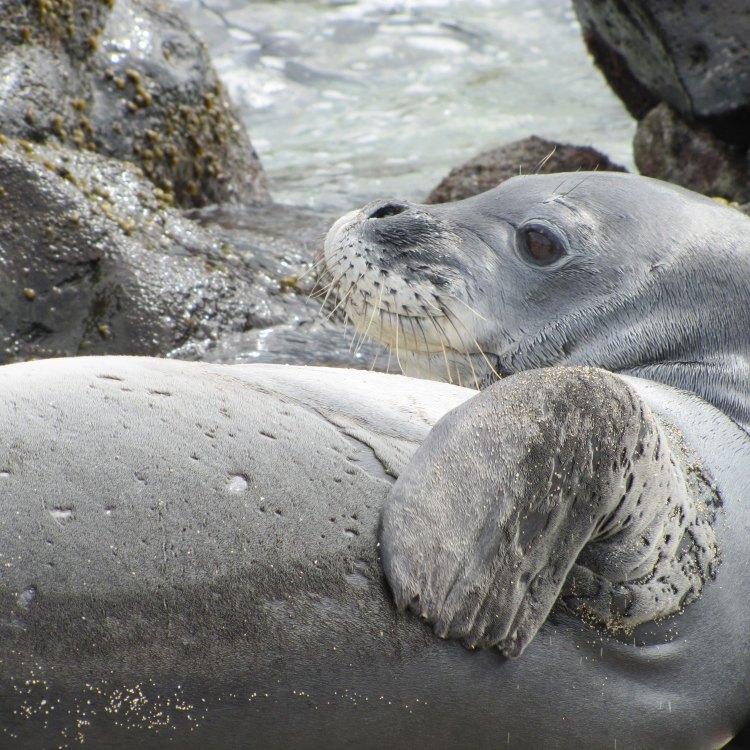
Hawaiian Monk Seal
- Adult Size: Weight between 375 and 600 pounds (170-270 kilograms)
- Average Lifespan: 25 to 30 years
- Reproduction: Viviparous
- Reproductive Behavior: Mating occurs in water
- Sound or Call: Vocalizations include barks and growls
- Migration Pattern: Some individuals may undertake long-range movements
- Social Groups: Solitary, but may form small groups on land
- Behavior: Most active during the day
- Threats: Habitat loss, fishing gear entanglement, infectious diseases
- Conservation Status: Endangered
- Impact on Ecosystem: Important top predator, helps maintain ecosystem balance
- Human Use: Hunted for their fur in the past
- Distinctive Features: Short, flat snout and large, black eyes
- Interesting Facts: One of the most endangered seal species in the world
- Predator: Sharks, possibly large fish
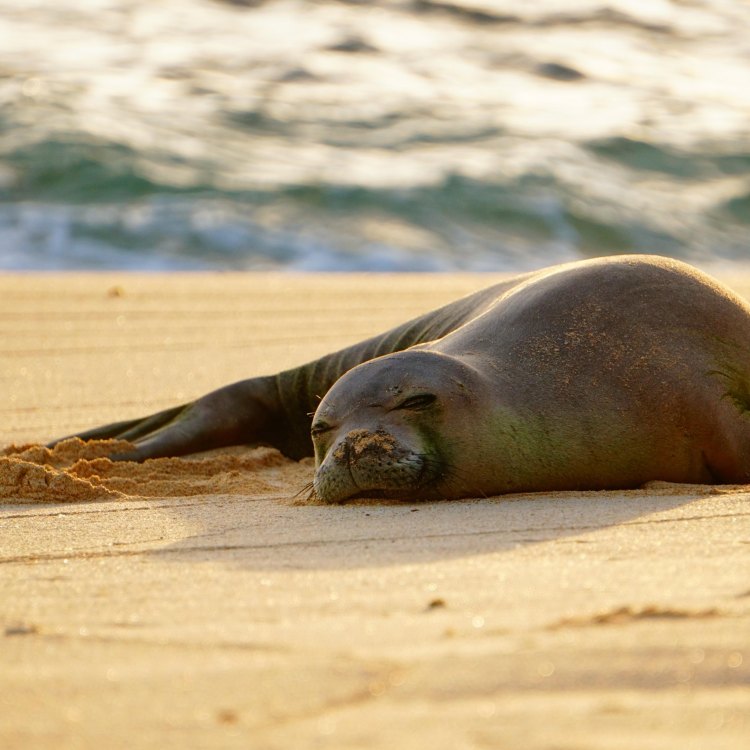
Monachus schauinslandi
The Endangered Hawaiian Monk Seal: A Mysterious and Mighty Creature
The ocean is a vast and mysterious realm, filled with fascinating creatures. One such creature is the Hawaiian Monk Seal, a unique and endangered species that calls the warm waters of the Pacific Ocean home. With an adult size ranging between 375 and 600 pounds and an average lifespan of 25 to 30 years, this majestic animal is a vital part of Hawaii's ecosystem. In this article, we will delve into the distinctive features, behaviors, and conservation efforts surrounding the Hawaiian Monk Seal PeaceOfAnimals.Com.Reproduction is a critical aspect of any species, and the Hawaiian Monk Seal is no exception. As a viviparous animal, females give birth to live young instead of laying eggs. This reproductive strategy allows the mother to provide her offspring with nutrients and protection in the womb, increasing their chances of survival.
Unlike most marine mammals, mating for Hawaiian Monk Seals occurs in water. Male seals will compete for the attention of females, often engaging in vigorous fights to establish dominance. Once a female has chosen a mate, she will swim to a secluded area to give birth, typically on a sandy beach. These ritualistic behaviors are essential for the survival of the species, ensuring genetic diversity and strong offspring.
Similar to other seals, the Hawaiian Monk Seal has a range of vocalizations, from barks to growls. These sounds are vital for communication between individuals, especially during the mating season Horseshoe Crab. Interestingly, researchers have also observed that these seals can mimic sounds, possibly learning to imitate other animals to avoid predators.
Migration is a common behavior among many animals, and the Hawaiian Monk Seal is no exception. While most individuals are solitary creatures, some may undertake long-range movements, spanning thousands of miles. These migrations are crucial for the species' survival, as they allow for genetic diversity and ensure the continued success of the species.
While Hawaiian Monk Seals are typically solitary creatures, they may form small groups on land. This behavior is especially common during the molting season, where several seals will gather on the beach to shed their old coats and grow a new one. This process can take up to two weeks and is essential for the seal's survival as their coat protects them from the sun, making it an incredibly vulnerable time for the animal.
The Hawaiian Monk Seal is most active during the day, with individuals spending the majority of their time foraging for food. These seals primarily feed on a diet of fish and squid, using their sharp teeth and powerful jaws to catch prey. Their role as top predators is vital to maintaining a balanced ecosystem, ensuring the health and well-being of their environment.
Unfortunately, Hawaiian Monk Seals face numerous threats, primarily due to human activities. Habitat loss, such as coastal development and climate change, has greatly impacted the species. Additionally, many seals become entangled in fishing gear left in the ocean, leading to severe injuries and even death.
Infectious diseases are another significant threat to the Hawaiian Monk Seal population. In recent years, an outbreak of the Toxoplasma gondii parasite has greatly affected the species, causing devastating effects on their reproductive abilities. Conservation efforts, such as regular health screenings and monitoring, are crucial in combating these threats and ensuring the species' survival.
The Hawaiian Monk Seal is listed as endangered on the International Union for Conservation of Nature (IUCN) Red List. There are currently less than 1,400 individuals left in the wild, making it one of the most endangered seal species in the world. The Hawaiian Monk Seal's status highlights the urgent need for conservation efforts to protect and preserve this unique and vital species.
Apart from their role in maintaining a balanced ecosystem, Hawaiian Monk Seals also have a fascinating history with humans. In the past, these seals were hunted for their fur, leading to a significant decline in their population. However, since the Hawaiian Monk Seal's protection under the Endangered Species Act in 1976, hunting has been banned, and conservation efforts have been put in place to ensure their survival.
One of the most distinctive features of the Hawaiian Monk Seal is its short snout and large, black eyes. These physical attributes make them instantly recognizable and give them a unique appearance compared to other seal species. In addition, their thick, oily fur allows them to spend a significant amount of time in the water, preventing them from getting cold and ensuring their survival in the harsh ocean environment.
Despite their size and strength, Hawaiian Monk Seals face the threat of predators. Sharks are known to prey on these seals, as well as other large fish, such as tuna. To avoid being hunted, Hawaiian Monk Seals spend most of their time at sea, using their natural camouflage in the water to hide from potential predators.
In conclusion, the Hawaiian Monk Seal is a mysterious and mighty creature that plays a crucial role in Hawaii's delicate ecosystem. From their unique reproductive behaviors to their important role as top predators, these seals are an essential part of our oceans. However, their population is under threat, and urgent conservation efforts are needed to preserve and protect this species. By raising awareness and taking action to address the threats they face, we can help ensure that the Hawaiian Monk Seal will continue to thrive in the warm waters of the Pacific for generations to come.
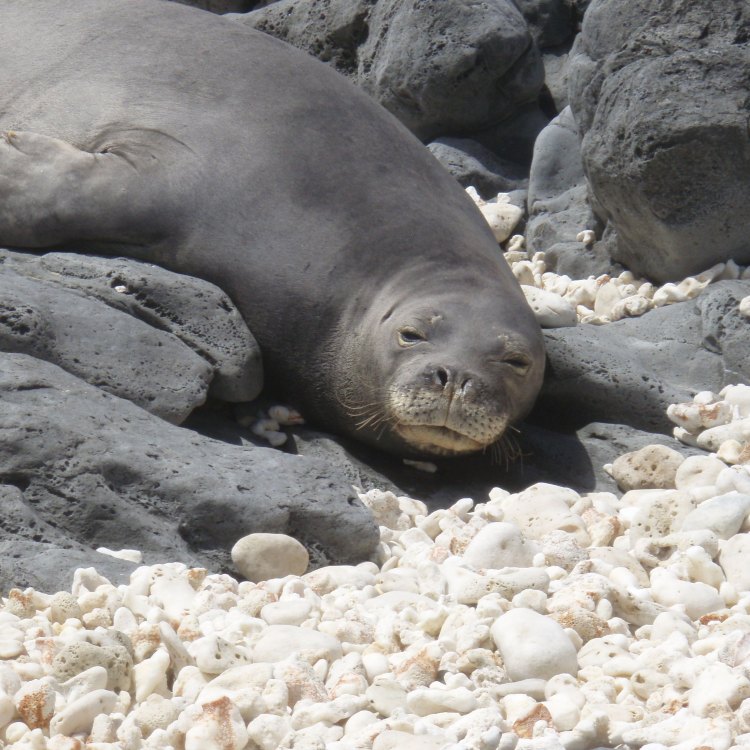
The Enigmatic Hawaiian Monk Seal: A Mysterious Creature of the Pacific
Disclaimer: The content provided is for informational purposes only. We cannot guarantee the accuracy of the information on this page 100%. All information provided here may change without prior notice.



